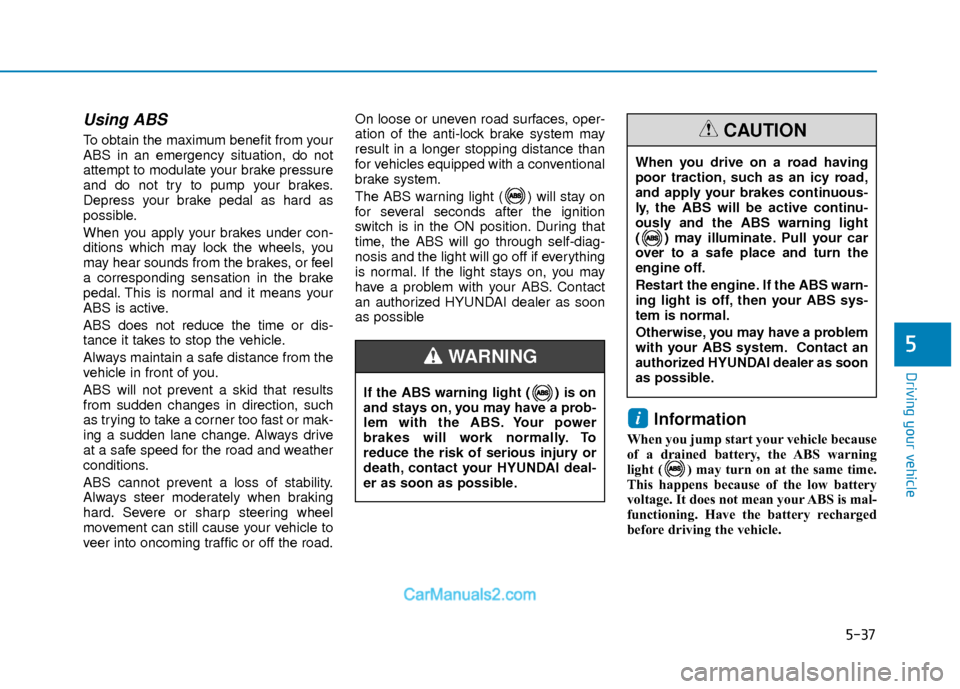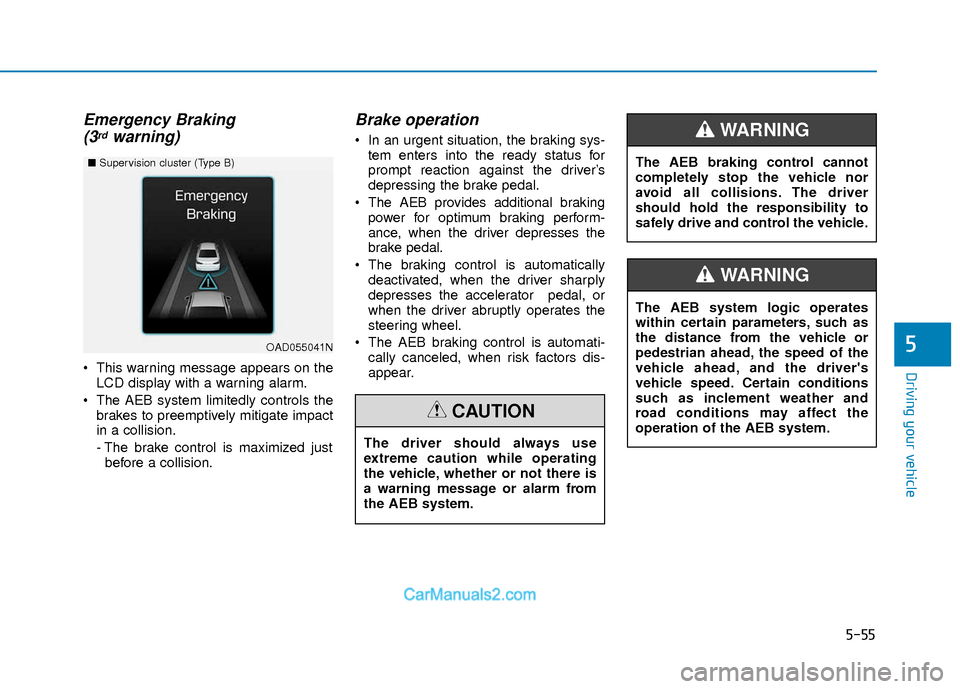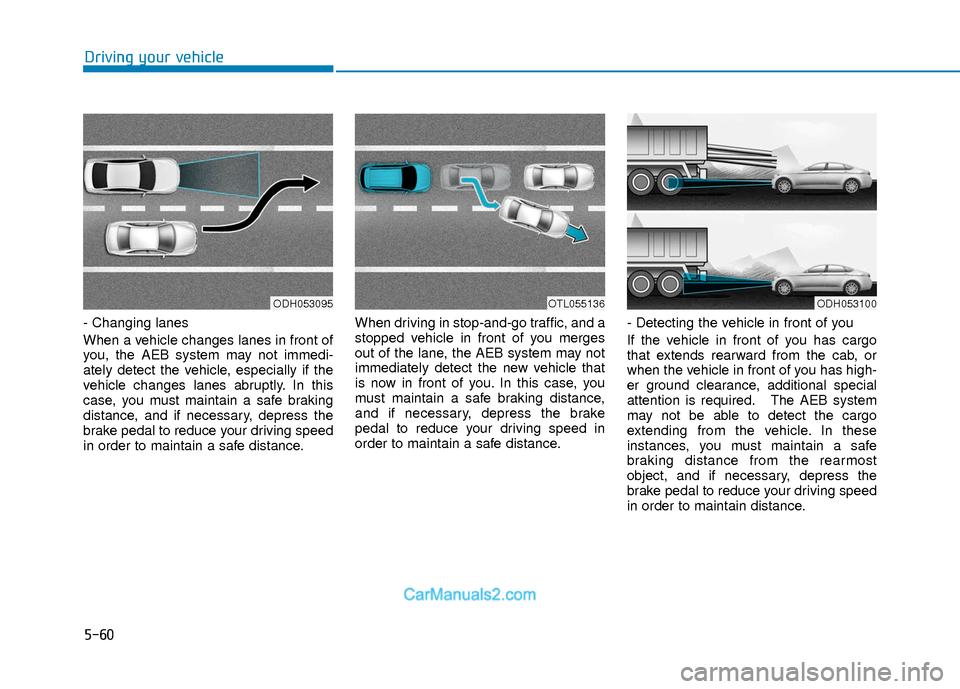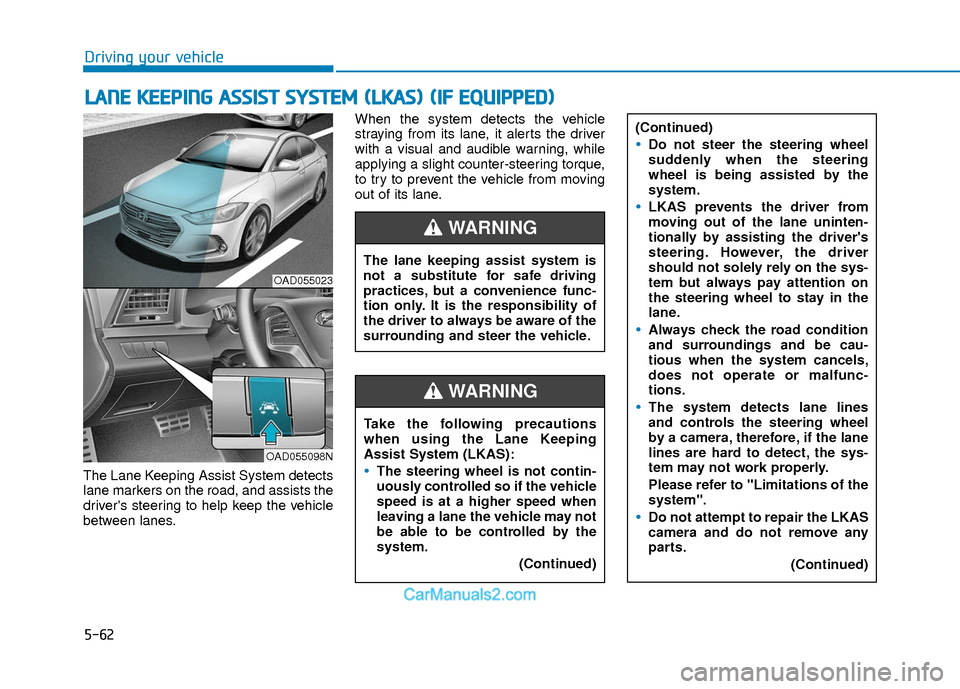2018 Hyundai Elantra ESP
[x] Cancel search: ESPPage 320 of 526

5-37
Driving your vehicle
5
Using ABS
To obtain the maximum benefit from your
ABS in an emergency situation, do not
attempt to modulate your brake pressure
and do not try to pump your brakes.
Depress your brake pedal as hard as
possible.
When you apply your brakes under con-
ditions which may lock the wheels, you
may hear sounds from the brakes, or feel
a corresponding sensation in the brake
pedal. This is normal and it means your
ABS is active.
ABS does not reduce the time or dis-
tance it takes to stop the vehicle.
Always maintain a safe distance from the
vehicle in front of you.
ABS will not prevent a skid that results
from sudden changes in direction, such
as trying to take a corner too fast or mak-
ing a sudden lane change. Always drive
at a safe speed for the road and weather
conditions.
ABS cannot prevent a loss of stability.
Always steer moderately when braking
hard. Severe or sharp steering wheel
movement can still cause your vehicle to
veer into oncoming traffic or off the road.On loose or uneven road surfaces, oper-
ation of the anti-lock brake system may
result in a longer stopping distance than
for vehicles equipped with a conventional
brake system.
The ABS warning light ( ) will stay on
for several seconds after the ignition
switch is in the ON position. During that
time, the ABS will go through self-diag-
nosis and the light will go off if everything
is normal. If the light stays on, you may
have a problem with your ABS. Contact
an authorized HYUNDAI dealer as soon
as possible
Information
When you jump start your vehicle because
of a drained battery, the ABS warning
light ( ) may turn on at the same time.
This happens because of the low battery
voltage. It does not mean your ABS is mal-
functioning. Have the battery recharged
before driving the vehicle.
i
If the ABS warning light ( ) is on
and stays on, you may have a prob-
lem with the ABS. Your power
brakes will work normally. To
reduce the risk of serious injury or
death, contact your HYUNDAI deal-
er as soon as possible.
WARNING
When you drive on a road having
poor traction, such as an icy road,
and apply your brakes continuous-
ly, the ABS will be active continu-
ously and the ABS warning light
( ) may illuminate. Pull your car
over to a safe place and turn the
engine off.
Restart the engine. If the ABS warn-
ing light is off, then your ABS sys-
tem is normal.
Otherwise, you may have a problem
with your ABS system.
Contact an
authorized HYUNDAI dealer as soon
as possible.
CAUTION
Page 321 of 526

5-38
Driving your vehicle
Electronic Stability Control
(ESC)
The Electronic Stability Control (ESC)
system helps to stabilize the vehicle dur-
ing cornering maneuvers. ESC checks
where you are steering and where the
vehicle is actually going. ESC applies
braking pressure to any one of the vehi-
cle's brakes and intervenes in the engine
management system to assist the driver
with keeping the vehicle on the intended
path. It is not a substitute for safe driving
practices. Always adjust your speed and
driving to the road conditions.
ESC operation
ESC ON condition
When the ignition switch is in the ON
position, the ESC and the ESC OFF indi-
cator lights illuminate for approximately
three seconds. After both lights go off,
the ESC is enabled.
When operating
When the ESC is in operation,
the ESC indicator light blinks:
When you apply your brakes under conditions which may lock the wheels,
you may hear sounds from the brakes,
or feel a corresponding sensation in
the brake pedal. This is normal and it
means your ESC is active.
When the ESC activates, the engine may not respond to the accelerator as
it does under routine conditions.
If the Cruise Control was in use when the ESC activates, the Cruise Control
automatically disengages. The Cruise
Control can be reengaged when the
road conditions allow. See "Cruise
Control System" later in this chapter. (if
equipped)
When moving out of the mud or driving on a slippery road, the engine RPM
(revolutions per minute) may not
increase even if you press the acceler-
ator pedal deeply. This is to maintain
the stability and traction of the vehicle
and does not indicate a problem.
OAD055010N
Never drive too fast for the road
conditions or too quickly when cor-
nering. The ESC system will not
prevent accidents.
Excessive speed in turns, abrupt
maneuvers, and hydroplaning on
wet surfaces can result in severe
accidents.
WARNING
Page 324 of 526

5-41
Driving your vehicle
5
Vehicle Stability Management
(VSM)
The Vehicle Stability Management (VSM)
is a function of the Electronic Stability
Control (ESC) system. It helps ensure
the vehicle stays stable when accelerat-
ing or braking suddenly on wet, slippery
and rough roads where traction over the
four tires can suddenly become
uneven.
VSM operation
VSM ON condition
The VSM operates when:
The Electronic Stability Control (ESC)is on.
Vehicle speed is approximately above 9 mph (15 km/h) on curve roads.
Vehicle speed is approximately above 12 mph (20 km/h) when the vehicle is
braking on rough roads.
When operating
When you apply your brakes under con-
ditions which may activate the ESC, you
may hear sounds from the brakes, or feel
a corresponding sensation in the brake
pedal. This is normal and it means your
VSM is active.
The VSM does not operate when:
Driving on a banked road such asgradient or incline.
Driving rearward.
ESC OFF indicator light is on.
EPS (Electric Power Steering) warn- ing light ( ) is on or blinks.
VSM OFF condition
To cancel VSM operation, press the ESC
OFF button. ESC OFF indicator light ( )
will illuminate.
To turn on VSM, press the ESC OFF but-
ton again. The ESC OFF indicator light
will go out.
Driving with wheels and tires with differ-
ent sizes may cause the ESC system to
malfunction. Before replacing tires, make
sure all four tires and wheels are the
same size. Never drive the vehicle with
different sized tires and wheels installed.
NOTICE
Take the following precautions
when using the Vehicle Stability
Management (VSM):
ALWAYS check the speed and the
distance to the vehicle ahead. The
VSM is not a substitute for safe
driving practices.
Never drive too fast for the road
conditions. The VSM system will
not prevent accidents. Excessive
speed in bad weather, slippery
and uneven roads can result in
severe accidents.
WARNING If ESC indicator light ( ) or EPS
warning light ( )
stays on or blinks, your vehicle may
have a malfunction with the VSM
system. When the warning light illu-
minates, have your vehicle checked
by an authorized HYUNDAI dealer
as soon as possible.
WARNING
Page 327 of 526

5-44
Driving your vehicle
When the ECO mode is activated:
The acceleration response may beslightly reduced if the accelerator
pedal is depressed moderately.
The air conditioner performance may be limited.
The shift pattern of the automatic transmission/dual clutch transmission
may change.
The engine speed may be lower than when driving in NORMAL mode.
The above situations are normal condi-
tions when the ECO mode is activated to
improve fuel efficiency. Limitation of the ECO mode opera-
tion:
Even though ECO mode is selected and
there is no change in the ECO indicator :
When the coolant temperature is low,
ECO mode will be limited until engine
temperature is at normal operating
temperature.
When driving up a hill, ECO mode will be limited to provide better power
when driving uphill.
When driving the vehicle with the auto- matic transmission/ dual clutch trans-
mission gear shift lever in manual shift
mode, ECO mode will be limited
according to the shift position.SPORT mode
SPORT mode manages the
driving dynamics by automat-
ically adjusting the steering
effort, and the engine and
transmission control logic for enhanced
driver performance.
When SPORT mode is selected by pressing the DRIVE MODE button, the
SPORT indicator will illuminate.
Whenever the engine is restarted, the Drive Mode will revert back to NOR-
MAL mode. If SPORT mode is desired,
re-select SPORT mode from the
DRIVE MODE button.
When SPORT mode is activated: - The engine rpm will tend to remainraised over a certain length of time
even after releasing the accelerator
- Upshifts are delayed when accelerat- ing
Information
In SPORT mode, the fuel efficiency may
decrease.
i
Page 338 of 526

5-55
Driving your vehicle
5
Emergency Braking(3rdwarning)
This warning message appears on the
LCD display with a warning alarm.
The AEB system limitedly controls the brakes to preemptively mitigate impact
in a collision.
- The brake control is maximized justbefore a collision.
Brake operation
In an urgent situation, the braking sys- tem enters into the ready status for
prompt reaction against the driver’s
depressing the brake pedal.
The AEB provides additional braking power for optimum braking perform-
ance, when the driver depresses the
brake pedal.
The braking control is automatically deactivated, when the driver sharply
depresses the accelerator pedal, or
when the driver abruptly operates the
steering wheel.
The AEB braking control is automati- cally canceled, when risk factors dis-
appear.
OAD055041N
■ Supervision cluster (Type B)
The driver should always use
extreme caution while operating
the vehicle, whether or not there is
a warning message or alarm from
the AEB system.
CAUTION
The AEB system logic operates
within certain parameters, such as
the distance from the vehicle or
pedestrian ahead, the speed of the
vehicle ahead, and the driver's
vehicle speed. Certain conditions
such as inclement weather and
road conditions may affect the
operation of the AEB system.
WARNING
The AEB braking control cannot
completely stop the vehicle nor
avoid all collisions. The driver
should hold the responsibility to
safely drive and control the vehicle.
WARNING
Page 340 of 526

5-57
Driving your vehicle
5
System Malfunction
When the AEB is not working properly,the AEB warning light ( ) will illumi-
nate and the warning message will
appear for a few seconds. After the
message disappears, the master warn-
ing light ( ) will illuminate. In this
case, have the vehicle inspected by an
authorized HYUNDAI dealer.
The AEB warning message may appear along with the illumination of
the ESC warning light.
■ Supervision cluster (Type B)
OAD055018/OLF056473N
The AEB is only a supplemental
system for the driver’s conven-
ience. The driver should hold the
responsibility to control the vehi-
cle operation. Do not solely
depend on the AEB system.
Rather, maintain a safe braking
distance, and, if necessary,
depress the brake pedal to
reduce the driving speed.
In certain instances and under
certain driving conditions, the
AEB system may activate prema-
turely. This initial warning mes-
sage appears on the LCD display
with a warning chime.
Also, in certain instances the
front radar sensor or camera
recognition system may not
detect the vehicle or pedestrian
ahead. The AEB system may not
activate and the warning mes-
sage will not be displayed.
(Continued)
WARNING (Continued)
If there is a malfunction with the
AEB system, the automatic emer-
gency braking is not applied even
though the braking system is
operating normally.
The AEB system operates only to
detect vehicles or pedestrians in
front of the vehicle.
The AEB system does not oper-
ate when the vehicle is in reverse.
The AEB system is not designed
to detect other objects on the
road such as animals.
The AEB system does not detect
cross traffic vehicles that are
approaching.
The AEB system cannot detect
the driver approaching the side
view of a parked vehicle (for
example on a dead end street.)
In these cases, you must main-
tain a safe braking distance, and
if necessary, depress the brake
pedal to reduce the driving speed
in order to maintain a safe dis-
tance.(Continued)
Page 343 of 526

5-60
Driving your vehicle
- Changing lanes
When a vehicle changes lanes in front of
you, the AEB system may not immedi-
ately detect the vehicle, especially if the
vehicle changes lanes abruptly. In this
case, you must maintain a safe braking
distance, and if necessary, depress the
brake pedal to reduce your driving speed
in order to maintain a safe distance.When driving in stop-and-go traffic, and a
stopped vehicle in front of you merges
out of the lane, the AEB system may not
immediately detect the new vehicle that
is now in front of you. In this case, you
must maintain a safe braking distance,
and if necessary, depress the brake
pedal to reduce your driving speed in
order to maintain a safe distance.
- Detecting the vehicle in front of you
If the vehicle in front of you has cargo
that extends rearward from the cab, or
when the vehicle in front of you has high-
er ground clearance, additional special
attention is required. The AEB system
may not be able to detect the cargo
extending from the vehicle. In these
instances, you must maintain a safe
braking distance from the rearmost
object, and if necessary, depress the
brake pedal to reduce your driving speed
in order to maintain distance.
ODH053095OTL055136ODH053100
Page 345 of 526

5-62
Driving your vehicle
The Lane Keeping Assist System detects
lane markers on the road, and assists the
driver's steering to help keep the vehicle
between lanes.When the system detects the vehicle
straying from its lane, it alerts the driver
with a visual and audible warning, while
applying a slight counter-steering torque,
to try to prevent the vehicle from moving
out of its lane.
L L
A
A N
N E
E
K
K E
EE
EP
P I
IN
N G
G
A
A S
SS
SI
IS
S T
T
S
S Y
Y S
ST
T E
EM
M
(
( L
L K
K A
A S
S)
)
(
( I
IF
F
E
E Q
Q U
UI
IP
P P
PE
ED
D )
)
OAD055023
OAD055098N
The lane keeping assist system is
not a substitute for safe driving
practices, but a convenience func-
tion only. It is the responsibility of
the driver to always be aware of the
surrounding and steer the vehicle.
WARNING
Take the following precautions
when using the Lane Keeping
Assist System (LKAS):
The steering wheel is not contin-
uously controlled so if the vehicle
speed is at a higher speed when
leaving a lane the vehicle may not
be able to be controlled by the
system.
(Continued)
WARNING
(Continued)
Do not steer the steering wheel
suddenly when the steering
wheel is being assisted by the
system.
LKAS prevents the driver from
moving out of the lane uninten-
tionally by assisting the driver's
steering. However, the driver
should not solely rely on the sys-
tem but always pay attention on
the steering wheel to stay in the
lane.
Always check the road condition
and surroundings and be cau-
tious when the system cancels,
does not operate or malfunc-
tions.
The system detects lane lines
and controls the steering wheel
by a camera, therefore, if the lane
lines are hard to detect, the sys-
tem may not work properly.
Please refer to "Limitations of the
system".
Do not attempt to repair the LKAS
camera and do not remove any
parts.(Continued)